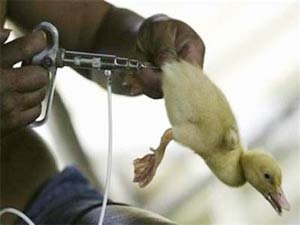H5N1 virus changes dangerously for humans!
Quang Thinh
According to a new study published, the H5N1 avian influenza virus has changed to be able to grow well in the respiratory tract on humans. This finding shows that H5N1 has constantly evolved to be more dangerous than before.
On October 4, Dr. Yoshihiro Kawaoka, head of research at the University of Wisconsin-Madison (USA), said the H5N1 virus has changed to make it easier to spread to humans, even though it hasn't yet. turned into a new virus, capable of causing disease in humans. According to Mr. Kawaoka, this change is very worrying.
He said: 'We have just discovered that the H5N1 virus has been specifically modified to help them grow well in the upper respiratory tract of humans.'

Ducks are being vaccinated against bird flu in China.The H5N1 virus has been modified to develop well in the upper respiratory tract of humans.(Photo: Reuters)
According to him, "the current strain of avian influenza virus in Africa and Europe is changing strains that can spread to humans." The normal temperature of the poultry body is 41 ° C, higher than the human body temperature (37 ° C) and also higher than the normal temperature in the nose and throat of humans. Therefore, according to Mr. Kawaoka, 'in general, H5N1 virus cannot develop well in human nose or throat'.
But Mr Kawaoka said they have been modified to live at lower temperatures in the human body.
In a report in the Public Library Library of America (PLoS Pathogens), the team said that all the virus samples collected from poultry species in Africa and Europe have changed. in the above direction.
Speaking to the press, Mr. Kawaoka said: 'I don't want to worry the public, because they can't do anything. But what's important is that the community of scientists needs to understand what's going on . ' All flu viruses are constantly evolving. So scientists are trying to find out which gene mutations can help them infect humans.
Two years ago, H5N1 caused the first mass death of waterbirds in Qinghai Lake, central China, where a large number of migratory poultry congregated.
It is the migratory poultry that brought H5N1 virus from Asia to Africa and then to Europe. And over time, the next generation of viruses has changed to become dangerous for humans.
Although the H5N1 virus is mainly infected in poultry, H5N1 has infected 329 people in 12 countries since 2003, of which 201 have died. Currently, it is rare for H5N1 to pass from person to person, but once the virus changes to make it easier, it can cause a global epidemic.
- Modified H5N1 virus can spread from pigs to humans
- H5N1 flu appears in poultry in Ninh Thuan
- WHO caucus about the most dangerous virus created by humans
- The H5N1 variant can spread to humans through respiration
- Detection of the H5N1 virus strain by a test
- Restart studies of H5N1
- H5N1 virus is evolving
- Cats infected with H5N1 virus?
- IAEA uses nuclear technology against H5N1 virus
- WHO announces the study of variant H5N1 avian influenza virus
- H5N1 avian influenza virus
- H5N1 virus lives for six days
 March 2012: Launching H5N1 vaccine for poultry
March 2012: Launching H5N1 vaccine for poultry Experts comment on the mysterious gradual disappearance of the Delta variant in Japan
Experts comment on the mysterious gradual disappearance of the Delta variant in Japan Danger of the two Delta . branch variants
Danger of the two Delta . branch variants 2020 pandemic flu attack humans?
2020 pandemic flu attack humans?